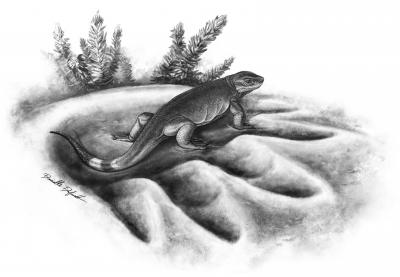
In this artist’s impression, the newly-discovered, tiny, carnivorous Eocasea martini hides in the footprint of its later descendant, the half-tonne plant-eater Cotylorhynchus. (Credit: Danielle Dufault, via University of Toronto Mississauga)
A new paper shows that giant herbivores evolved from much smaller creatures like the newly discovered Eocasea martini, a carnivore only 20 cm long.
The study shows that similar transitions of small carnivores to large herbivores happened independently at least five times, setting the stage for the giant herbivores of 270 million years ago. These carnivores are today’s giant herbivores like rhinos, elephants and hippopotamus.
Original research paper published in the PLOS One on April 16, 2014.
Names and affiliations of selected authors

